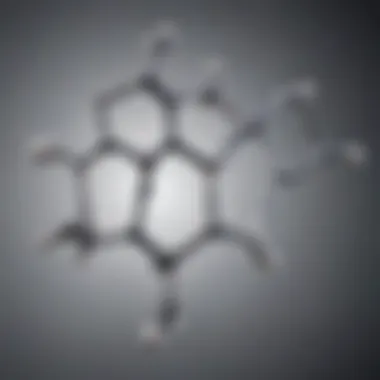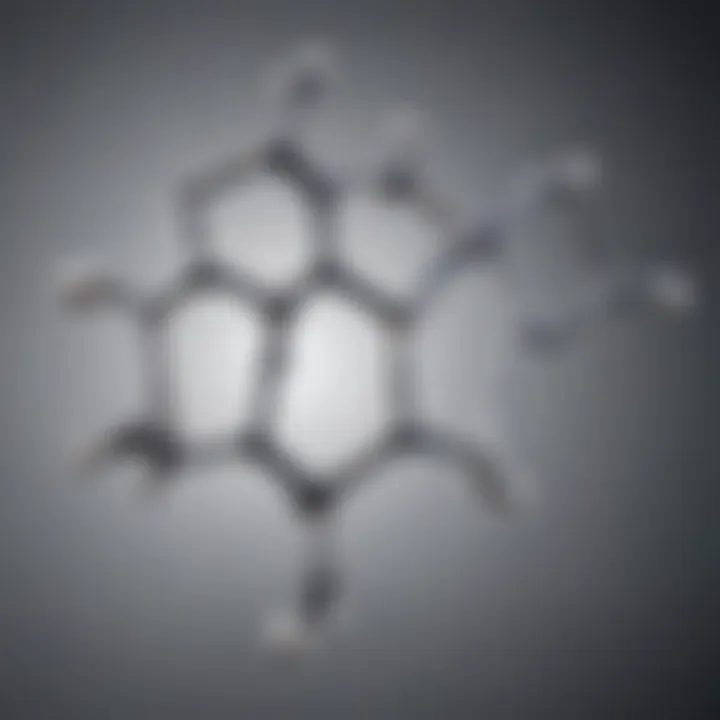Exploring Amine Functionalized Graphene Oxide Properties


Article Overview
Purpose of the Article
The purpose of this article is to provide a thorough examination of amine functionalized graphene oxide (AFGO). This material presents unique characteristics that emerge through the process of functionalization. Understanding these properties is vital for harnessing AFGO in various applications. This article will clarify the synthesis methods and the resultant effects on material behavior, paving the way for future innovations in materials science.
Relevance to Multiple Disciplines
The study of AFGO is relevant across several scientific fields. In medicine, it offers potential for targeted drug delivery and imaging. In energy, AFGO may enhance the efficiency of batteries and supercapacitors. Environmental science finds use in pollutant removal and water purification. Each of these applications demonstrates the interdisciplinary nature of AFGO research, making it a crucial topic for researchers, educators, and professionals.
Research Background
Historical Context
The development of graphene oxide began in the early 2000s as researchers sought to understand the properties of graphene. The functionalization process, specifically with amine groups, originated to improve the material's compatibility with various solvents and biological systems. The exploration of AFGO has steadily increased, reflecting its importance in novel applications.
Key Concepts and Definitions
- Graphene Oxide: A single-atom-thick sheet of carbon atoms arranged in a hexagonal lattice, oxide functionalities integrated throughout.
- Functionalization: The chemical modification of a substance to introduce new functional groups, enhancing properties.
- Amine Groups: Organic compounds characterized by the presence of nitrogen atoms, affecting chemical and physical properties.
Understanding these key concepts is crucial for delving deeper into the attributes and applications of AFGO.
"The functionalization of graphene oxide significantly alters its properties and opens new avenues for research and application across multiple disciplines."
"The functionalization of graphene oxide significantly alters its properties and opens new avenues for research and application across multiple disciplines."
The exploration of AFGO goes beyond superficial attributes. It is essential to consider the chemical reactions involved in the functionalization process and their impact on the resultant material. Each aspect plays a role in shaping further developments in this rapidly evolving field.
Prolusion to Graphene Oxide
Graphene oxide (GO) has garnered significant attention in the field of materials science due to its exceptional properties and potential applications. Understanding GO is crucial as it serves as the foundation for amine functionalization, which enhances its functionality and usability in various fields. The importance of this topic lies not only in the material's unique characteristics but also its relevance in advancing technologies in areas such as electronics, energy, and biomedical research.
Definition and Structure
Graphene oxide is a single-atom-thick planar sheet of sp2-bonded carbon atoms with numerous oxygen-containing groups. These functional groups include epoxide, hydroxyl, and carboxyl groups, which largely contribute to its hydrophilicity and reactivity. The arrangement of graphene oxide can be described as a layered structure, which is significant for its physical and chemical properties. The presence of these functional groups creates a versatile platform for further modification, enabling the introduction of various functionalities through chemical reactions.
Synthesis Methods
The fabrication of graphene oxide can be approached through different synthetic methods. The two most common strategies are top-down and bottom-up approaches. Each method has its unique processes and implications for the properties of the resulting material.
Top-down approaches
Top-down approaches involve the exfoliation of bulk graphite into graphene oxide. This can be done through methods such as chemical oxidation or mechanical cleavage. A key characteristic of top-down methods is that they produce larger quantities of material, making it a popular choice for research and industrial applications. The primary advantage of these methods lies in their scalability, allowing for bulk production without the need for complex apparatus. However, the disadvantage is that the resulting graphene oxide often contains defects and a higher degree of disorder compared to those produced via bottom-up methods. This could impact the material's electrical and thermal properties.
Bottom-up approaches
Bottom-up approaches, on the other hand, synthesize graphene oxide by chemical vapor deposition or liquid-phase synthesis. This method assembles the graphene layer by layer, often allowing for better control over the structure and properties. A key characteristic of bottom-up approaches is their ability to create higher-quality graphene oxide, which can exhibit fewer defects and greater homogeneity. Nevertheless, these techniques may require more time and resources, and their scalability can pose challenges. In general, bottom-up methods are favored for applications that require precise material properties, such as in electronics and optoelectronics.
Understanding Amine Functionalization
Amine functionalization plays a crucial role in enhancing the properties and applicability of graphene oxide, transforming it from a simple carbon structure into a versatile material with numerous functionalities. The introduction of amine groups modifies the surface chemistry of graphene oxide, which in turn leads to significant improvements in chemical reactivity, hydrophilicity, and biological compatibility. These changes are important when considering the integration of amine functionalized graphene oxide in diverse fields such as medicine, environmental science, and energy storage. Understanding the implications of amine functionalization is essential for researchers as they aim to tailor material properties for specific applications.
Role of Amine Groups
Amine groups are significant when functionalizing graphene oxide. They provide various benefits, including increased hydrophilicity, which facilitates dispersion in aqueous media. This characteristic makes amine functionalized graphene oxide an excellent candidate for biological applications, such as drug delivery and bioimaging. Moreover, the presence of amine functional groups enables stronger interactions with other molecules, enhancing the potential for composite material formation. The functionalization can modulate the surface charge properties of graphene oxide, ultimately influencing adhesion and interaction with different substrates.
Functionalization Mechanisms


The methods of functionalization can determine the efficiency and effectiveness of amine groups on graphene oxide. Two widely used strategies are nucleophilic substitution and reduction methods. These approaches allow for the incorporation of amine groups in a controlled manner, influencing the resultant material's characteristics.
Nucleophilic Substitution
Nucleophilic substitution is a favored technique for introducing amine groups onto graphene oxide. It involves the reaction of a nucleophile—usually an amine compound—attacking an electrophilic center in the graphene oxide structure. One of the key characteristics of this process is its specificity. This means researchers can selectively modify specific sites on the graphene oxide sheet.
Nucleophilic substitution is beneficial because it can enhance the chemical stability and tunability of the resultant amine functionalized graphene oxide. The unique feature of this method is its ability to preserve the basal plane of graphene oxide during the reaction, maintaining its advantageous properties. However, some challenges may arise, such as the potential formation of by-products if the reaction conditions are not optimized, necessitating careful control of parameters during the functionalization.
Reduction Methods
Reduction methods provide another pathway for the functionalization of graphene oxide with amine groups. This technique typically involves the reduction of oxygen-containing groups present on graphene oxide while simultaneously introducing amine functionalities. A notable characteristic of this method is its ability to improve the conductivity of the resulting material, making it appealing for electronic and energy storage applications.
The unique feature of reduction methods lies in their dual benefit: not only do they add amine groups, they also enhance the electrical properties of the graphene oxide. However, the challenges can stem from the condition's complexity, as uncontrolled reduction might lead to over-reduction, negatively impacting the structural integrity of the material. Understanding these methods allows researchers to finely tune graphene oxide properties, ultimately leading to tailored applications across different fields.
Properties of Amine Functionalized Graphene Oxide
Understanding the properties of amine functionalized graphene oxide (AFGO) is crucial to appreciate its potential in various applications. The unique characteristics of AFGO result from the integration of amine groups on the graphene oxide surface. This functionalization alters the material's behavior, making it applicable in fields such as medicine, energy storage, and environmental science. The three primary properties examined in this section are its chemical stability, electrical conductivity, and surface chemistry. These properties are vital when considering the practical applications and effectiveness of AFGO.
Chemical Stability
Chemical stability refers to the ability of AFGO to remain unchanged under specific conditions. Amine functionalization enhances this stability, especially under various environmental factors. The introduction of amine groups can improve interactions with solvents and other materials. This stability ensures that AFGO retains its properties over time, which is essential in biomedical applications where long-term performance is required.
Electrical Conductivity
Electrical conductivity is another significant property of AFGO. It is essential for applications in electronics and energy storage. The amine functionalization process can influence electron mobility within the material. This enhancement occurs due to a combination of structural properties and the electronic nature of attached amine groups.
Research indicates that AFGO can exhibit tunable conductivity depending on the degree of functionalization. This tunability allows for a tailored approach to optimize performance in devices such as supercapacitors and lithium-ion batteries. Amine functionalized graphene oxide can bridge the gap between insulating and conductive materials, offering a versatile solution for diverse electronic needs. Thus, understanding and manipulating electrical conductivity can significantly expand the use of AFGO in advanced technological applications.
Surface Chemistry
The surface chemistry of AFGO plays a pivotal role in its applications. The presence of amine groups alters the interactions at the material's surface. These modifications can enhance the attachment of biomolecules, making AFGO particularly suitable for biomedical applications. The alteration also affects the material's interaction with other compounds, allowing for better adsorption of pollutants in environmental cleanup efforts.
AFGO's surface properties can be finely tuned through different functionalization techniques. The ability to control these characteristics is vital for developing effective systems for drug delivery and pollutant removal. The highly reactive surface allows for easy conjugation with various molecules, leading to improved performance in intended applications.
In summary, the unique surface chemistry enabled by amine functionalization significantly influences the effectiveness of AFGO in multiple fields. By leveraging these properties, researchers can design and develop innovative solutions that address current challenges in science and technology.
The properties of amine functionalized graphene oxide are essential for its applications across several industries, highlighting the material's versatile nature and suitability for cutting-edge research.
The properties of amine functionalized graphene oxide are essential for its applications across several industries, highlighting the material's versatile nature and suitability for cutting-edge research.
Applications of Amine Functionalized Graphene Oxide
Amine functionalized graphene oxide (AFGO) has gained significant attention for its wide range of applications. This interest stems from the unique properties imparted by amine groups, enhancing the material’s functionality across various fields. The importance of these applications lies not only in their scientific relevance but also in their potential to address pressing global issues. Each application showcases the versatility and adaptability of AFGO in real-world scenarios.
Biomedical Applications
Drug delivery systems
Drug delivery systems utilizing AFGO are notable for their ability to improve the efficiency of drug transport within the body. The key characteristic of these systems is the controlled release of therapeutic agents. This feature makes AFGO a beneficial choice for targeting specific tissues or cells. With its large surface area and the ability to form stable complexes with drugs, AFGO enables enhanced solubility and bioavailability.
The unique feature of drug delivery systems using AFGO is their ability to encapsulate pharmaceutical compounds. This provides a protective environment for sensitive medications, preventing degradation before reaching the target site. However, challenges such as potential toxicity and the need for precise targeting mechanisms remain important considerations in the development of these systems.
Bioimaging
Bioimaging based on AFGO offers promising advances in the visualization of biological processes. The key characteristic here is the high contrast and resolution it brings to imaging techniques. This makes it a popular option in both research and clinical settings. AFGO can be doped with various imaging agents, enhancing its effectiveness in tracking disease progression.
A unique feature of bioimaging with AFGO is its multifunctionality. It can serve both as an imaging agent and drug carrier, allowing for simultaneous diagnosis and treatment. However, it is crucial to balance sensitivity and specificity in imaging applications, as overactive signals can lead to misinterpretations of data.


Energy Storage Solutions
Supercapacitors
In the realm of energy storage, supercapacitors that incorporate AFGO hold immense potential due to their high capacitance and fast charge-discharge rates. Their key characteristic is the ability to deliver significant power in short bursts. This makes them a beneficial option for applications requiring rapid energy release, such as in electric vehicles and regenerative braking systems.
A unique feature of supercapacitors with AFGO is their exceptional cycling stability. They can endure numerous charge and discharge cycles without significant loss of performance. On the downside, the energy density of supercapacitors may be lower compared to traditional batteries, which can limit their application range.
Lithium ion batteries
Lithium ion batteries using AFGO have seen advancements, particularly in terms of conductivity and efficiency. The key characteristic of these batteries is their ability to enhance charge transfer processes. This makes AFGO a popular additive for improving overall battery performance and lifespan.
One unique feature of lithium ion batteries with AFGO is the potential for reduced charging times. The improved conductivity allows for faster ion movement, resulting in shorter charging cycles. Nevertheless, challenges regarding the long-term stability of AFGO within battery systems continue to pose a concern.
Environmental Remediation
Heavy metal adsorption
In environmental applications, AFGO is explored for its capacity in heavy metal adsorption, addressing water contamination issues. The key characteristic here is its high adsorption capacity, which provides effective removal of toxic metals from water sources. This makes it a beneficial solution for environmental cleanup efforts.
The unique feature of heavy metal adsorption with AFGO is its selective binding capabilities. It can target specific metals while minimizing the uptake of non-toxic substances. However, the efficiency of this process can be influenced by factors such as pH and competing ions in the solution.
Pollutant degradation
Pollutant degradation using AFGO represents a promising approach to combat environmental pollution. The key characteristic of this application is its ability to catalyze the breakdown of complex organic pollutants. This capacity positions AFGO as a beneficial tool in wastewater treatment and remediation projects.
A unique feature of pollutant degradation with AFGO is its integration with other catalytic materials. This allows for enhanced degradation rates and broader applicability across various types of contaminants. Despite these advantages, the challenge remains in optimizing reaction conditions to achieve maximum degradation efficiency.
Recent Advancements in AFGO Research
The field of amine functionalized graphene oxide (AFGO) is growing rapidly. Recent advancements have significantly impacted its synthesis and applications. Researchers are continuously exploring novel methods to enhance properties and expand the usage of AFGO. These advancements present opportunities for better functionalization processes and innovative applications in various domains.
Nanocomposite Development
Nanocomposites are materials composed of a matrix and nanoscale reinforcements. The integration of AFGO into nanocomposites has shown promising results in enhancing mechanical, thermal, and electrical properties. These enhanced composites can benefit industries such as electronics, automotive, and construction.
The use of AFGO in nanocomposites allows for a greater surface area and improved interaction between the components. It can lead to a more efficient transfer of load, resulting in stronger and lighter materials. Moreover, the presence of amine groups can improve the adhesion of AFGO to various matrix materials, fostering uniform dispersion.
Key benefits of nanocomposite development include:
- Enhanced mechanical strength: Higher durability and structural integrity.
- Improved thermal properties: Better heat resistance and thermal stability.
- Tailored electrical conductivity: Enhanced performance of electronic components.
"The synthesis of nanocomposites with AFGO reveals vast potential to advance materials science."
"The synthesis of nanocomposites with AFGO reveals vast potential to advance materials science."
Sustainable Synthesis Methods
As environmental considerations become crucial in research, the focus on sustainable synthesis methods for AFGO has intensified. Traditional methods often involve hazardous chemicals and extensive energy usage. Therefore, more eco-friendly approaches are being developed.
Sustainable methods may include:
- Green chemistry techniques: Utilizing renewable materials and non-toxic reagents to minimize environmental impact.
- Biomass-derived precursors: Sourcing carbon from plants or waste materials, thereby reducing reliance on fossil fuels.
- Low-temperature synthesis: Reducing energy consumption during the production process.
These methods not only reduce environmental harm but also lead to cost-effective and scalable production of AFGO. The push for sustainability is likely to remain a central theme in future AFGO research, making it an important area of focus for both academics and industry professionals.
Challenges and Limitations


The advancement of amine functionalized graphene oxide (AFGO) presents not only unique opportunities but also notable challenges. Understanding these challenges is crucial for researchers and industry practitioners aiming to utilize AFGO effectively. The limitations encountered during the production and application phases can significantly impact the functionality and economic viability of this material. In this section, we will explore the specific elements of scalability in production and material stability.
Scalability of Production
To effectively harness the benefits of AFGO, scalable production methods are essential. Currently, many synthesis techniques, including functionalization approaches, remain limited in their ability to produce large quantities at a consistent quality. Factors affecting scalability include:
- Complex processes: Some synthesis methods involve multiple steps that can complicate scalability.
- Cost efficiency: Production costs can be prohibitive if the methods are not optimized for larger batches.
- Quality control: Maintaining quality across larger volumes can pose significant challenges. Any variability in the properties of AFGO can limit its reliability for specific applications.
Scaling production also demands a thorough assessment of environmental impacts. Processes employed must not only be efficient but must also comply with sustainability standards. Therefore, developing new methodologies that prioritize both quantity and quality remains a pressing need in the field of graphene oxide research.
Material Stability in Applications
Another significant challenge lies in the material stability of AFGO during practical applications. Stability concerns can arise under various conditions, including:
- Environmental factors: Exposure to humidity and temperature changes can affect the performance of AFGO.
- Chemical interactions: The presence of competing substances can result in unwanted reactions, impacting the functionality of AFGO in applications.
- Mechanical integrity: In structural applications, AFGO must maintain its stability under mechanical stress, which can often lead to degradation.
Understanding these stability issues is vital for the successful adoption of AFGO in diverse applications. Researchers must investigate the interplay of these stability factors and develop strategies to mitigate potential risks.
"Addressing the challenges related to scalability and stability is crucial for the advancement of AFGO in real-world applications."
"Addressing the challenges related to scalability and stability is crucial for the advancement of AFGO in real-world applications."
Overall, while AFGO presents substantial advantages, it is imperative to confront these challenges proactively. Development of robust production methods and an emphasis on material stability will be pivotal to the future success of AFGO, allowing it to fully realize its potential in numerous fields.
Future Directions in AFGO Research
The study of amine functionalized graphene oxide (AFGO) is at a critical juncture. Research is uncovering its extensive capabilities across various fields. Future directions in AFGO research are vital in addressing the growing demands for advanced materials. This section explores key aspects that could define its trajectory.
Intersection with Other Nanomaterials
Combining AFGO with other nanomaterials can enhance its properties significantly. For instance, when integrated with carbon nanotubes, the mechanical strength and electrical conductivity of the composite can be markedly improved. The synergy between AFGO and materials like silver nanoparticles or titanium dioxide could lead to enhanced antibacterial properties, beneficial in biomedical applications.
Potential intersections to consider:
- Carbon Nanotubes: Improved strength and conductivity.
- Metal Nanoparticles: Enhanced catalytic properties for environmental remediation.
- Polymers: Creation of hybrid materials for flexible electronics.
These combinations may produce multifunctional materials. The challenge lies in finding optimal methods for integration while maintaining the unique benefits of AFGO.
Innovative Applications Beyond Current Trends
The current applications of AFGO are significant, yet many unexplored opportunities exist. Future research might venture into sectors like flexible electronics or smart textiles. Integrating AFGO into wearable technology for health monitoring could become a reality, pushing the boundaries of biomedical engineering.
Some innovative concepts include:
- Data Storage: AFGO's high surface area could enable advancements in supercapacitors for quick energy storage.
- Sensory Applications: Development of AFGO-based sensors for real-time environmental monitoring.
- Photocatalysis: Utilization in solar energy conversion processes.
These directions reflect a growing recognition of AFGO as not merely a component but as a fundamental building block in next-generation materials. Exploring these innovative avenues will require interdisciplinary collaboration and a focus on practical implementations.
In summary, the future of AFGO research promises exciting possibilities. Understanding intersections with other nanomaterials and expanding its applications can shape its role in science and technology. Amidst these explorations, research must prioritize sustainability and scalability, ensuring that these advanced materials can be produced and utilized effectively.
End
The conclusion of this article encapsulates the essential insights regarding amine functionalized graphene oxide (AFGO) and its significant role in contemporary materials science and nanotechnology. By synthesizing the key properties and applications, it becomes evident how AFGO stands at the intersection of innovation and functionality in various fields.
One of the most important aspects discussed is the unique properties that amine functionalization imparts to graphene oxide. The modification enhances chemical stability, electrical conductivity, and surface chemistry, allowing AFGO to be utilized effectively in multiple applications. This functional versatility is crucial, as researchers and professionals seek materials that can meet complex demands across different domains, from medical treatments to energy storage solutions.
Moreover, the exploration of AFGO in biomedical applications—such as drug delivery systems and bioimaging—substantiates its potential to revolutionize healthcare practices. In energy applications, the promise of improved supercapacitors and lithium-ion batteries demonstrates the growing interest in sustainable energy resources and innovative materials that can contribute to this sector.
"Understanding the advancements and potential of AFGO can guide future research toward addressing the global challenges we face today, such as environmental pollution and energy depletion."
"Understanding the advancements and potential of AFGO can guide future research toward addressing the global challenges we face today, such as environmental pollution and energy depletion."
Overall, the article not only highlights current trends and challenges in AFGO research but also encourages consideration of future directions. The intersection of AFGO with other nanomaterials and the exploration of innovative applications remain open areas that require further investigation.



